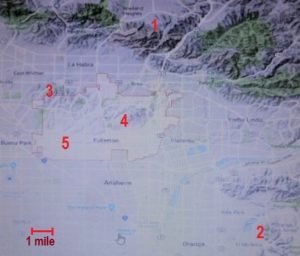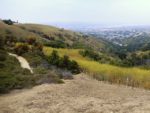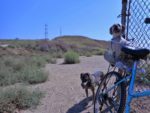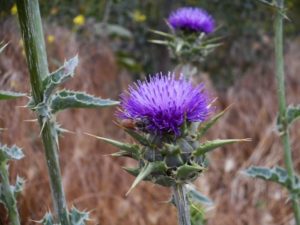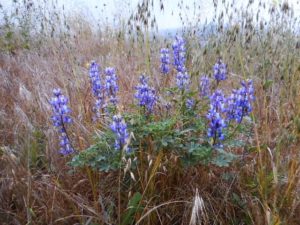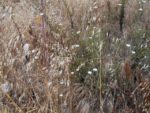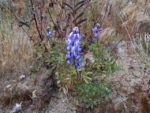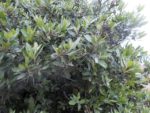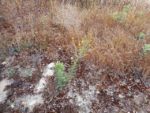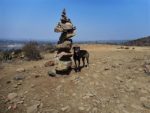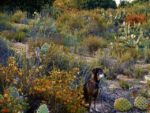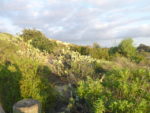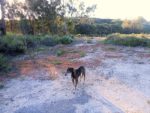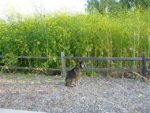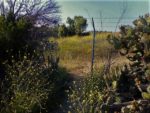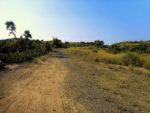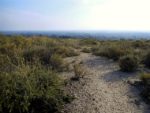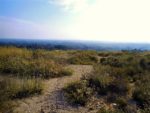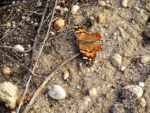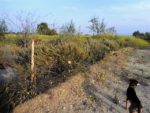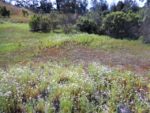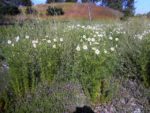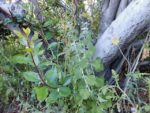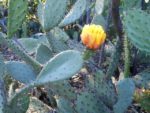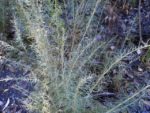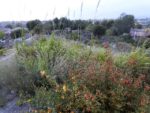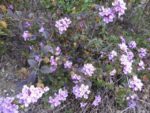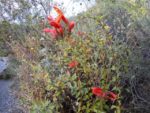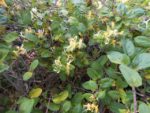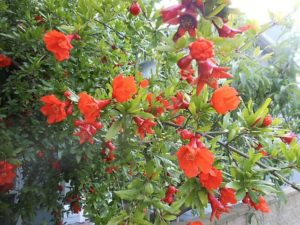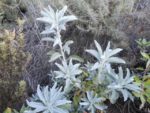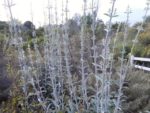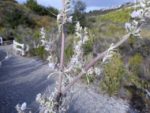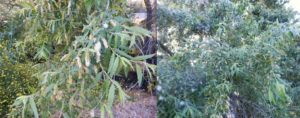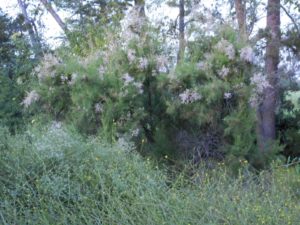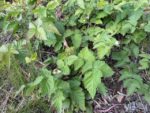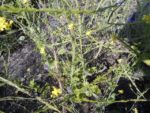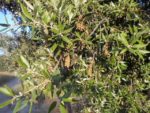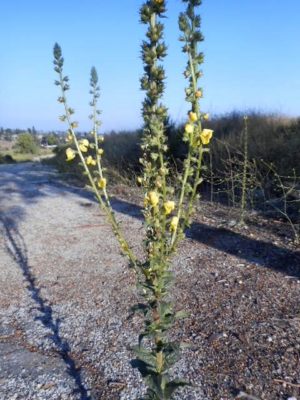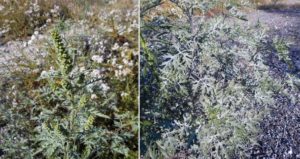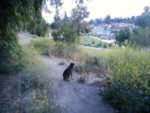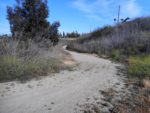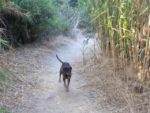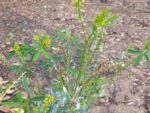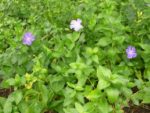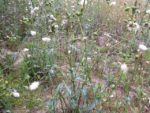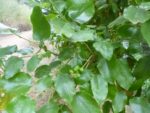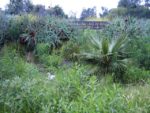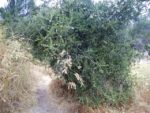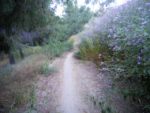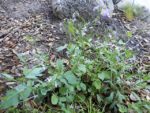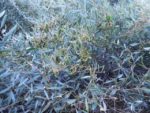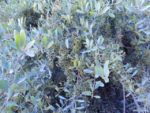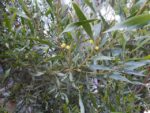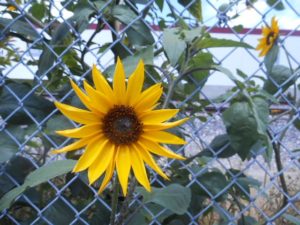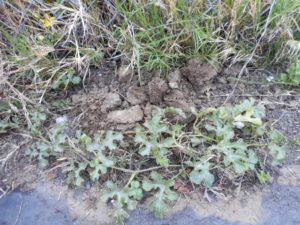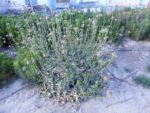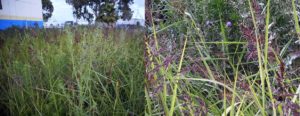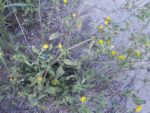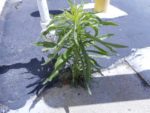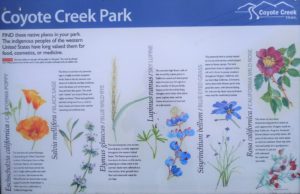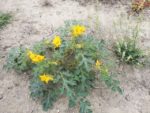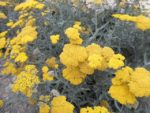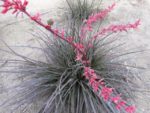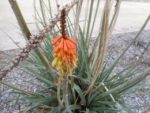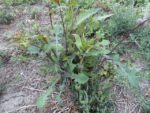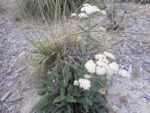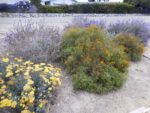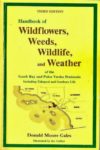Colors: purple = native, orange = non-native
olive = weed, green = flower, blue = tree
0o Aleppo Pine (Pinus halepensis) xxxxxxxxxxxx
3h Arroyo Willow (Salix lasiolepis) xxxxxxxxxxx
4b Baby Blue-eyes (Nemophila menziesii) xxxxx
3c Black Mustard (Brassica nigra) xxxxxxxxxxxx
6b Black Sage (Salvia mellifera) xxxxxxxxxxxxxx
3e Bladderpod (Peritoma arborea) xxxxxxxxxxxx
3d Blue Elderberry (Sambucus mexicana) xxxxx
4b Blue Palo Verde (Parkinsonia florida) xx xxxx
4d Brazilian Pepper (Schinus terebinthifolia) xxx
5b Bristly Ox-tongue (Picris echioides) xxx xxxx
3g Brittlebush (Encelia farinosa) xxxxxxxxxxxxx
6b Buffalo-bur (Solanum rostratum) xxxxxxxxxx
1a Buffalo Gourd (Cucurbita foetidissima) xxxxx
1b California Brittlebush (Encelia californica) xx
3f Calif. Buckwheat (Eriogonum fasciculatum) x
3g California Dodder (Cuscuta californica) xxxxx
4b California Goldfields (Lasthenia californica) x
00 Calif. Bay Laurel (Umbellularia californica) xx
0o California Mugwort (Artemisia douglasiana) x
6b California Poppy (Eschscholzia californica) xx
3e California Sycamore (Platanus racemosa) x x
1a California Walnut (Juglans californica) xxx xx
6b California Wild Rose (Rosa californica) xxxxx
3i Cape Plumbago (Plumbago auriculata) xx xxx
3g Castor Bean (Ricinus communis) xxxxxxxxxx
3h Cat-tail (Typha angustifolia) xxxxxxxxxxxxxxx
3c Chamise (Adenostoma fasciculatum) xxxxxxxx
0o Chaparral Whitehorn(Ceanothus leucodermis)
5a Cheese Weed (Malva parviflora) xxxxxxxx xxx
2a Coastal Prickly Pear (Opuntia littoralis) xxxxx
3d Coastal Sagebrush (Artemesia californica) x x
6a Coast Live Oak (Quercus agrifolia) xxxxxx xxx
4d Colorado Pinyon Pine (Pinus edulis) xxxx xxx
5a Common Sunflower (Helianthus annuus) xxx
3e Coyote Brush (Baccharis pilularis) xxxxxxxxxx
0o Creeping Woodsorrel (Oxalis corniculata) xxx
3d Deerweed (Lotus scoparius) xxxxxxxxxxxxxxx
5a Desert Willow (Chilopsis linearis) xxxxxxxxxx
1b Dwarf Olive (Olea europaea) xxxxxxxxxxxxxxx
4c Fairy Duster (Calliandra eriophylla) xxxxxxxxx
6b Flax-leaved Horseweed(Erigeron bonariensis)
0o Fringed Willowherb (Epilobium adenocaulon).
4a Giant Reed (Arundo donax) xxxxxxxxxxxxxxxx
5b Giant Rye Grass (Elymus condensatus) xx xxx
3d Golden Yarrow (Eriophyllum confertiflorum)xx
0o Hairy Ceanothus (Ceanothus oliganthus) x xxx
0o Hoary-leaf Ceanothus(Ceanothus crassifolius)
3g Heart-leaved Penstemon(Keckiella cordifolia)
0o Hoary Mustard (Hirschfeldia incana) xxxxxxxx
4e Horehound (Marrubium vulgare) xxxxxxxxxxx
5b Horseweed (Erigeron canadensis) xxxxxxxxxx
3f Hottentot Fig (Carpobrotus edulis) xxxxxxxxx
4b Italian Thistle (Carduus pycnocephalus) xxxx
0o Knobcone Pine (Pinus attenuata) xxxxxxxxxx
3g Laurel Sumac (Malosma laurina) xxxxxxxxxx
0o Lemonade Berry (Rhus integrifolia) xxxxxxx
0o Lemon-scented Gum (Eucalyptus citriodora)
0o Manna Gum (Eucalyptus vinimalus) xxxxxxxx
4e Matilija Poppy (Romneya coulteri) xxxxxxxxx
1b Milk Thistle (Silybum marianum) xxxxxxxxxx
3g Mule Fat (Baccharis salicifolia) xxxxxxxxxxxxx
4b Our Lords Candle (Yucca whipplei) xxxxxxxxx
3h Pacific Blackberry (Rubus ursinus) xxxxxxxxx
0o Pampas Grass (Cortaderia selloana) xxxxxxxx
4d Peruvian Pepper (Schinus molle) xxxxxxxxxx
4d Poison Hemlock (Conium maculatum) xxxxxx
0o Poison Oak (Toxicodendron diversilobum) xxxx
3h Prickly Lettuce (Lactuca serriola) xxxxxxxxxxx
0o Prickly Poppy (Argemone munita) xxxxxxxxxx
6b Pride of Madeira (Echium candicans) xxxxxxx
4e Purple Sage (Salvia leucophylla) xxxxxxxxxxxx
3g Red Bush Monkey Flower (Mimulus puniceus)
0o Red Willow (Salix laevigata) xxxxxxxxxxxxxxx
5a Russian Thistle (Salsola tragas) xxxxxxxxxxxx
4e Sacred Datura (Datura meteloides) xx xxxxxx
4b Scarlet Bugler (Penstemon centranthifolius) xx
4b Scrub Oak (Quercus dumosa) xxxxxxxxxxxxxx
1b Sky Lupine (Lupinus nanus) xxxxxxxxxxxxxxx
3f Sow Thistle (Sonchus oleraceus) xxxxxxxxxxx
4b Spear Thistle (Cirsium vulgare) xxxxxxxxxxxx
5b Star Thistle (Centaurea melitensis) xxxxxxxxx
3d Sticky Monkey Flower (Mimulus longiflorus) x
5a Stinging Nettles (Urtica holosericea) xxxxxxx
3e Stinking Chamomile (Anthemis cotula) xxxxx
4c Sweet Fennel (Foeniculum vulgare) xxx xxxxx
0o Tasmanian Blue Gum (Eucalyptus globulus) .x
1b Toyon (Heteromeles arbutifolia) xxxxxxx xxxxx
5a Tree Tobacco (Nicotiana glauca) xxxxxx xxxxx
4c Tule Reed (Schoenoplectus acutus) xxxxx xxxx
3e Wand Sage (Salvia vaseyi) xxxxxx xxxxxxxxxx
3e White Sage (Salvia apiana) xxxxxxxxxxxxxxxx
3e Wild Cabbage (Brassica oleracea) xxxx xxxxxx
3a Wild Cucumber (Marah macrocarpus) xxxxxxx
1b Wild Morning Glory (Convolvulus arvensis) xx
5a Wild Radish (Raphanus sativus) xxxxxxxxxxxx
5a Wild Watermelon (Citrillus lanatus) xxxxxxxx
Walk along streets and trails or through wild brush. Hear the many different bird sounds, owl hoots, ground squirrel chirps, and coyote calls. Smell the sweet wild flowers, aromatic sages and sagebrush, and pine trees. See beautiful things and learn about them.
About half of wild plants in this area are natives that have been here over 10,000 years. They all all say “We have been here longer than you can imagine. Enjoy us but don’t destroy us.” The other half are non-natives that were brought here recently in the last 300 years. They all say “Move over, we’re your new neighbors”. Some of the new neighbors are harmless and some are harmful.
Table of Contents:
1. Puente Hills
1a 2016-08 Puente Oil Field
1b 2019-05 Puente Oil Field
2. Orange Hills
2a 2018-08 El Modena Open Space
3. West Coyote Hills
3a 2017-02 Rosecrans Trail
3b 2019-03 Coyote Oil Field East
3c 2019-04 Ralph B. Clark Park
3d 2019-04 Coyote Oil Field West
3e 2019-05 Ralph B. Clark Park
3f 2019-05 Castlewood Trail
3g 2019-05 Hawks Pointe Trail
3h 2019-06 Bastanchury Creek
3i 2019-06 Ward Nature Preserve
4. East Coyote Hills
4a 2016-09 Brea Dam Rec. Area
4b 2019-05 Hillcrest Park
4c 2019-05 Laguna Lake Park
4d 2019-05 Brea Dam Park
4e 2019-06 Juanita Cooke Trail
4f 2019-06 Fullerton Creek
5. Urban Flatland
5a 2019-05 Myrons Mopeds
5b 2019-05 La Mirada U.P. Tracks
6. Coastal Flatland
6a 2018-05 Cal State Long Beach
6b 2019-06 Coyote Creek Park
7. Sources and Discussion
1. Puente Hills, Rowland Heights CA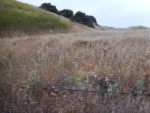
Rising up from the urban flatland of eastern Los Angeles County and the northern edge of Orange County, are the Puente Hills, running east-west from Whittier to Diamond Bar. The eastern end is mostly undeveloped, an old oil field that became cattle pasture. The southeast part of the oil field near Brea is still active.
1a. August 28 2016 Puente Oil Field
The eastern trail head starts at the top of Roland Heights, on the ridge, at the end of Vantage Point Dr. The summit nearby was once a missile launch site during the Cold War. Now most of the open land there is a cattle ranch.
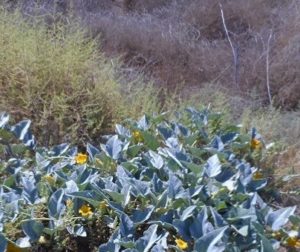
Everything else is brown, except this blue-green Buffalo Gourd (Cucurbita foetidissima). The fresh young fruit can be eaten by people, but the mature gourd cannot, due to bitter compounds.
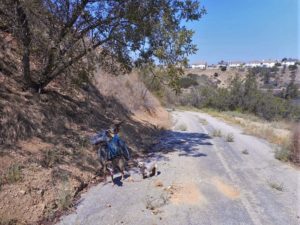
Stopping in the shade of a native California Black Walnut (Juglans californica). The shells are thick and hard to crack open, but the small nut inside tastes like a regular walnut.
1b. May 13 2019 Puente Oil Field
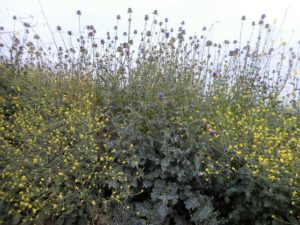
Surrounded by yellow blooming Wild Mustard is a patch of purple blooming Milk Thistle (Silybum marianum). The lower leaves have beautiful white lines. This fancy and scary plant is edible, when prepared properly (by removing the spines).
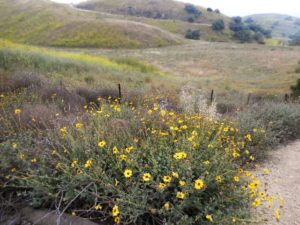
This is coastal California Brittlebush (Encelia californica), often seen on roadsides like here. The inland version of this, Encelia farinosa, is more gray-green, and exudes a resin that was used by used by native Americans to treat various body pains.
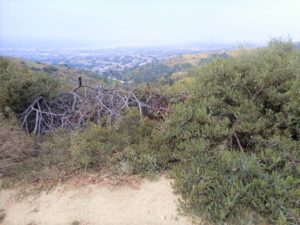
North view from the ridge looking down on Rowland Heights. Foreground is Dwarf Olive (Olea europaea), a shrub variety that does not produce fruit.
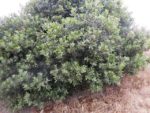
Rounded Toyon (Heteromeles arbutifolia) bushes dot the hillsides, along with oak. These evergreen shrubs are what Hollywood was named after.
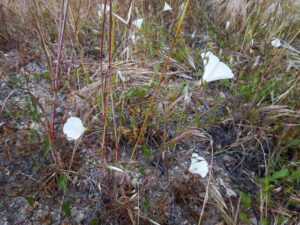
Start your day with a Wild Morning Glory (Convolvulus arvensis). This vine has flowers that are mostly white with some purple. The leaves are narrow compared to cultivated varieties.
2. Orange Hills, Orange CA
Rising out of the flat land of the eastern Los Angeles basin, southeast of Anaheim, are the Orange Hills, known to geologists as the El Modena Volcanics. Part of those hills is a nature preserve, the El Modena Open Space.
2a. August 26 2018 El Modena Open Space
These hills are cores of ancient volcanoes, where the molten basalt rock intruded up into the sedimentary layers. As the rock reached the surface, gas bubbles formed, like they do in carbonated beverage. So much of the rock there now is dark and full of round holes 1/16 to 1/2″. In some places groundwater later filled the holes and eventually left quartz crystals lining the walls of the bubble holes. Later the sandstone eroded away exposing the lava plugs. Some of the lava rock later eroded forming a chain of cone-shaped hills.
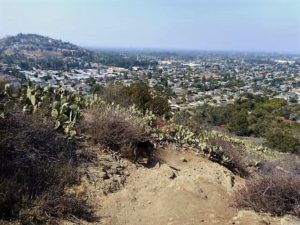
El Modena Open Space south view. In the background is the same kind of volcanic hill, but with residential development and a restaurant on top.
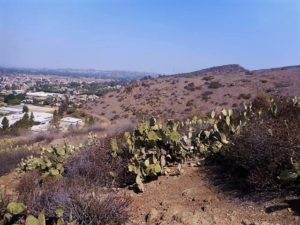
El Modena Open Space northwest view. The plants in front are brown Chamise with reddish brown dried flowers, and Coastal Prickly Pear Cactus (Opuntia littoralis), always green.
3. West Coyote Hills, Fullerton CA
Rising out of the urban flat land in the eastern Los Angeles basin, northwest of Anaheim, are the Coyote Hills. Part of those hills is the largest undeveloped piece of land in Orange County, owned by Chevron. It was an oil field from about 1900 to 1970, with over 100 wells. Now it’s a nature preserve, home to the endangered tiny gray California gnat catcher.
3a. Feb 06 2017 Rosecrans Trail West End
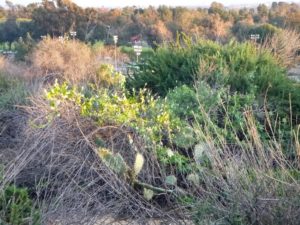
Some new growth from winter rain is Wild Cucumber (Marah macrocarpus). It’s flowering now, and soon will produce spiny bitter cucumbers. In 3 months it will be dead and brown.
This trail starts across the street from Ralph B. Clark Park, and climbs north up the hill. Part of this trail is on the original 1920’s paved road through the area. This is the same road shown in photos 3d below that goes off the top of a cliff, called the “road to nowhere”.
3b. March 10 2019 Coyote Oil Field – Eastern
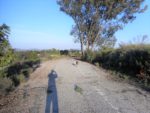
Looking northeast from the “high road”, this lonely Eucalyptus tree can be seen for miles. The line of trees in the distance is Euclid Ave. In the far distance is eastern Puente Hills and Chino Hills.
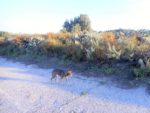
Here spiny Prickly Pear Cactus grows thick, making off trail travel impossible. Plenty of winter rain has caused Sticky Leaf Monkey Flower to cover the cactus in orange bloom.
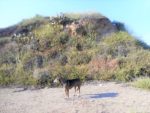
Most non-natives cannot live long in the dry climate. On the right, orange-brown lawn grass, dead after a month without water. Blooming yellow flowers of Black Mustard, upper left, lasts longer.
3c. April 20 2019 Ralph B. Clark Regional Park
These photos were taken from inside Ralph B. Clark Park. Parts of that park are nature preserves.
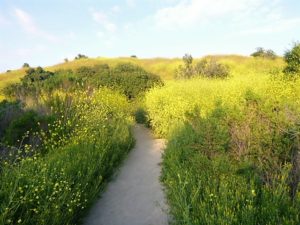
In front is Chamise (Adenostoma fasciculatum), considered to be the dominant species of the chaparral plant community. In back is six foot tall yellow Black Mustard (Brassica nigra), a non-native named for the color of it’s seeds.
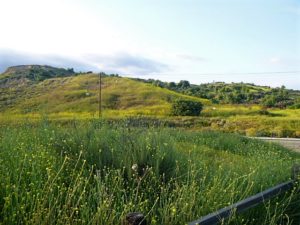
In the background is the former oil field. At far left is the start of the cliffs. On the back side of the mustard-colored ridge is a prickly pear cactus field, shown in the next exploration.
3d. April 27 2019 Coyote Oil Field – Western
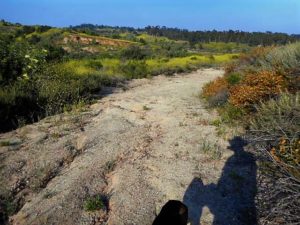
Here you can see the distant slope angle, going upward to the left. That angle is also the angle of the sandstone rock layers (strata). Behind that on the right horizon is a Eucalyptus grove.
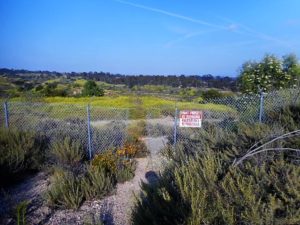
Right, coastal Coastal Sagebrush (Artemesia californica) resembles Rosemary and contains terpenes that give off a strongly aromatic odor. It relieves pain and repels insects. Animals won’t eat it. Native people used this plant medicinally. Artemesia californica liniment is said to be more powerful than opioids.
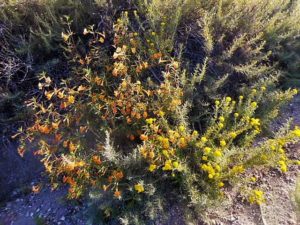
Left, orange Sticky Leaf Monkey Flower (Mimulus longiflorus). The orange to red flowers resemble a monkey face. Right, yellow Golden Yarrow (Eriophyllum confertiflorum) brightens your day. Top, Coastal Sagebrush is what you smell in undeveloped natural places, along with sage.
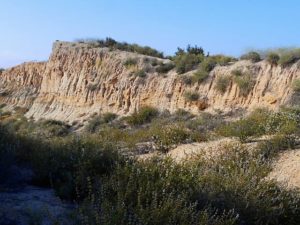
View of Hawks Point, elevation about 500 ft. The vertical grooves are from the massive excavation in the 1950’s and 60’s. Sand and gravel from here, the Emery Borrow Pit, was used by Caltrans to build the elevated 91 freeway.
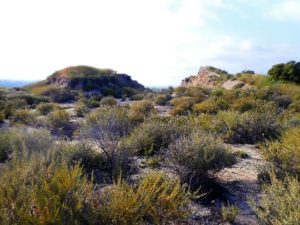
West view from the “promised land” cliff top.
In front is Deerweed (Lotus scoparius), blooming with tiny yellow and orange flowers. Deerweed roots have bacteria that convert nitrogen gas into nitrates, usable by plants. Each plant and animal benefits the entire natural community in some way, although the benefit may not be apparent.
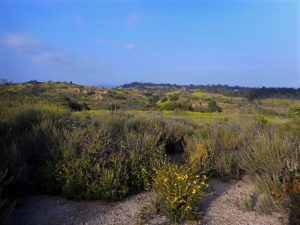
Another cliff top view looking northeast. In front center is Golden Yarrow. Left is aromatic White Sage. This area was cleared of vegetation in the 1960’s. Sagebrush, Chamise and White Sage live here. Hawks patrol the sky looking for rabbits and squirrels, gliding in slow circles on updrafts.
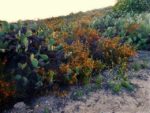
A field of Coastal Prickly Pear Cactus and Sticky Monkey Flower with a Blue Elderberry tree at right. Cactus fields like this were never cleared for oil extraction activities.
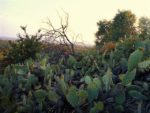
At the cliff edge is Blue Elderberry (Sambucus mexicana), aka Mexican Elderberry. The name is from sambuke, a flute-like musical instrument native people made from the pithy branches.
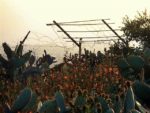
Mystery fence, between a cliff and a cactus field. Who would want to get poked by 100 needles and then fall off a cliff, to get over that fence?
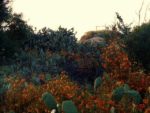
The highest cliff-edge fence “to nowhere” is the Fullerton to Buena Park city boundary. Like the road “to nowhere”, it was there before excavation created the cliffs.
3e. May 10 2019 Ralph B. Clark Regional Park
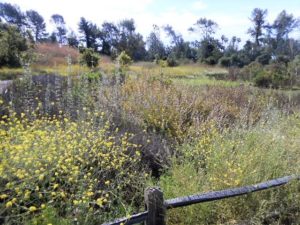
Clark Park’s low-lying natural area is home of the sage sisters, Wand Sage (Salvia vasevi), with long stalks and White Sage (Salvia apiana) with lavender flowers.
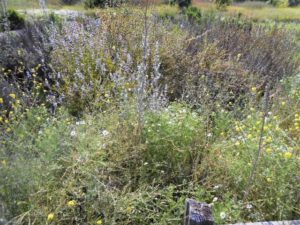
Lavender stalks of White Sage, the centerpiece of mother nature’s bouquet! White sage blooms are a major source of nectar used by bees to produce honey. At this time of year they always have bees on them gathering nectar.
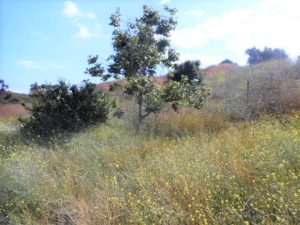
Center is California Sycamore (Platanus racemosa). In the background is tall brown dried out Black Mustard. Foreground yellow flowers are Wild Cabbage, which looks the same but is half as tall.
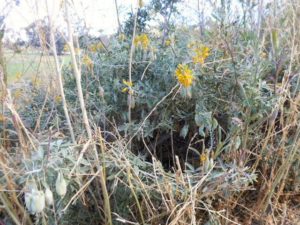
Interesting and unusual is this Bladderpod (Isomeris arborea) aka Burro Fat. It grows on hillsides and has a foul smell. The fruit is like an inflated pea pod. Ranchers value this for animal feed.
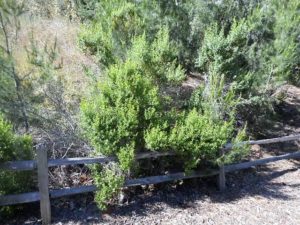
All green from irrigation is this healthy Coyote Brush (Baccharis pilularis). These common coastal sage scrub plants are usually part green, part brown when they’re not near sprinklers.
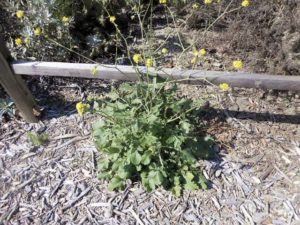
This young Wild Cabbage (Brassica Oleracea) has buds that look like broccoli. That’s because it is broccoli. Six common vegetables are varieties of this same wild species, broccoli, cauliflower, kale, cabbage, Brussels sprouts, and kohlrabi.
3f. May 17 2019 Castlewood Trail
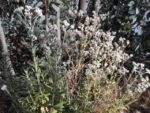
Here is Wild Buckwheat (Eriogonum fasciculatum). It has been used as a food crop and medicinal plant by various Native American tribes.
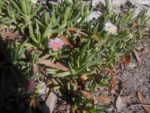
This widespread succulent is Hottentot Fig (Carpobrotus edulis), a native of South America. Commonly know as Ice Plant, it was used alongside freeways in the 1960’s and 70’s for erosion control. Its high water content would help control fires. Later it was learned that on steep slopes the extra weight would cause a land slide, after rains. So “ice plant” is not used on steep slopes anymore.
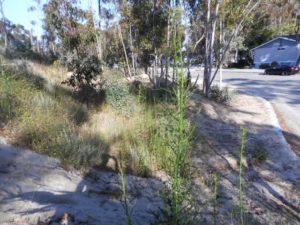
Here is a large Sow Thistle (Sonchus oleraceus). These are in “every” garden and flower bed. At maturity the flowers are small and cream colored, and the leaves and stems become purple-red. Here at the “edge of wild” weeds are allowed to grow. On the other side of the street they are not.
3g. May 22 2019 Hawks Pointe Trail
Hawks Point is a rock formation, visible for miles, where hawks glide on updrafts. It is 800 feet north of Rosecrans Ave, across the street from Ralph Clark Park. Hawks Pointe is a nearby gated community with nature trails.
The Rosecrans Trail, maintained by the City of Fullerton, leads to the Hawks Pointe trail network, maintained by the private community. The area was first Emery Ranch, then Coyote Oil Field, then motorcycle riding area, then in the 1970’s it was graded and developed. The nature trails area has returned to a wild state with variety and beauty.
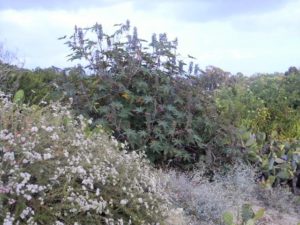
Center is Castor Bean (Ricinus communis), naturalized from the tropics. The seeds contain ricin, a very potent poison. Castor Bean Oil is a lubricant used in two-stroke engines that makes that “racing” smell. It is a great lubricant but leaves black carbon build-up, so it is only used in racing engines that are rebuilt and cleaned out often.
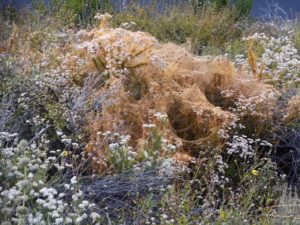
The orange stuff covering the blooming Chamise is a parasite called California Dodder (Cuscuta californica). Initially Dodder grows from seed and has green chlorophyll. But when a host is found, it changes into a parasite, sending out countless fibers that lack chlorophyll. The fibers absorb nutrients from the host plant. Here the host is Chamise but the preferred host is Laurel Sumac.
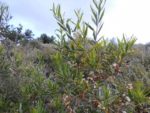
This is Mule Fat (Baccharis salicifolia). It’s leaves resemble willow. Early settlers used this shrub as a browse for their livestock.
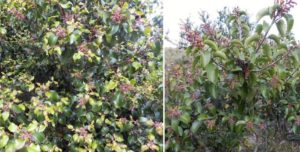
Here is miss Laurel Sumac (Malosma laurina), a common landscaping plant that resists pests and disease. Find her in the wild and around most parking lots. Easily identified by the dried flower clusters that do not fall off.
3h. June 3 2019 Bastanchury Creek
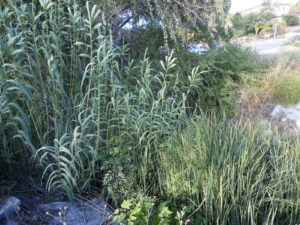
Here is a large image of water-loving plants. Left is Giant Reed, right is Cat-tail (Typha augustifolia), top is Arroyo Willow.
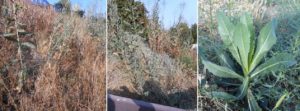
Here is old and young Prickly Lettuce (Lactua serriola), living in Edward White Park near Bastanchury Creek. It is distinguished from Stinging Nettles by the smooth stem.
3i. June 8 2019 Robert E. Ward Nature Preserve
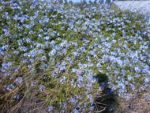
This is Cape Plumbago (Plumbago auriculata). It’s a cultivated flower that survives in the wild in places.
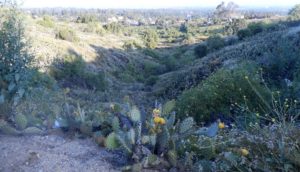
Large image looking southeast. Packs of coyotes sometimes howl around here at dusk. Disneyland is about 7 miles straight ahead.
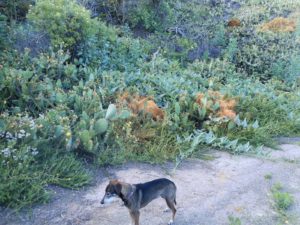
Maggie pauses in a large image of Prickly Pear topped with Buffalo Gourd, with an additional topping of orange stringy Dodder.
4. East Coyote Hills, Fullerton CA
East of Euclid Ave is Eastern Coyote Hills, which is mostly developed residential.
4a. Sep 18 2016 Brea Dam Recreation Area
This is a beautiful trash-free low-lying natural area, undeveloped because it’s a flood control basin.
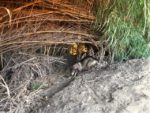
Maggie explores a sloping hole in a patch of Giant Reed (Arundo donax). The light at the end of the tunnel is Brea Creek.
4b. May 11 2019 Hillcrest Park
This wonderful hillside park opened in 1922. It has many trails, stairs, and surprises.
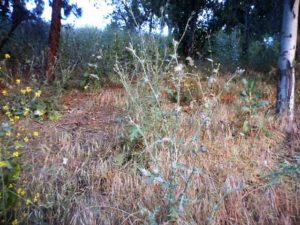
This is Italian Thistle (Carduus pycnocephalus), getting ready to bloom. It has 3 sets of vertical spiny fins going up the stems and needle-sharp spines on the leaves. Not appetizing.
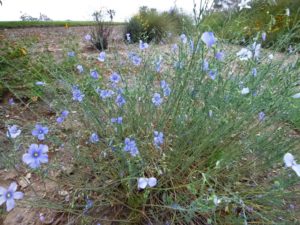
Here is Baby Blue-eyes (Nemophilia menziesii), a well known and cultivated wildflower. Here it is with contrasting orange California Poppy nearby.
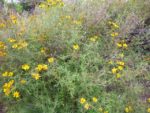
This is California Goldfields (Lasthenia californica). In the early spring these plants form a yellow carpet where grass is sparse.
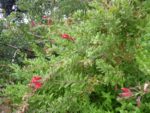
Introducing the Scarlet Bugler (Penstemon centranthifolius), one of the many native plants living in Hillcrest Park. Penstemon means the flowers have five stamens and one thread.
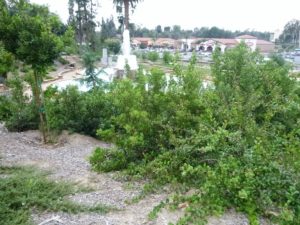
This is a large image looking south at the fountain in the lowest part of the park. At right is Scrub Oak (Quercus dumosa). Scrub Oak is lower growing with flatter and bigger leaves than Coast Live Oak.
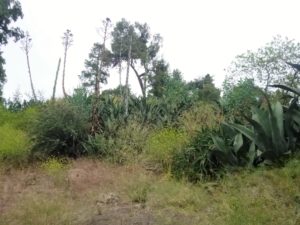
This is a large image of a patch of Our Lords Candle (Yucca whipplei). This giant yucca has the tallest flowers, at 10-15 feet. Some smaller yuccas are there mixed in.
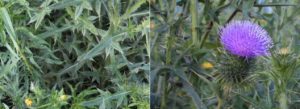
Here is a Spear Thistle (Cirsium vulgare). The flower looks like a Milk Thistle, but the stems are not spiny and the leaves do not have the white stripes.
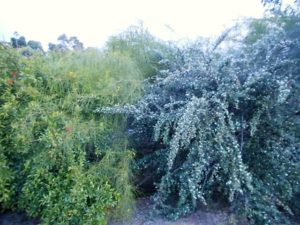
Left is Scarlet Bugler. Middle with thin green leafless twigs is Blue Palo Verde (Parkinsonia florida). It is common in the Sonoran Desert of Arizona and southeast California. Right is what?
4c. May 18 2019 Laguna Lake Park
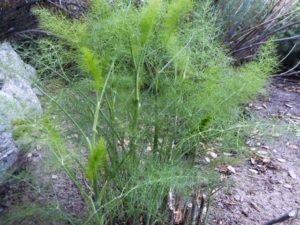
This a young Sweet Fennel (Foeniculum vulgare) aka Anise. The leaves and stem are edible like celery. They smell and taste like black licorice. Chew on that.
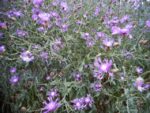
This showy flower is called Fairy Duster (Calliandra eriophylla), aka hairy leaf calliandra. It likes dry, gravely, alkaline soil like on some dry hillsides and desert washes.
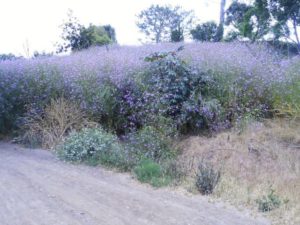
Here the lavender-pink Fairy Duster has taken over this one hill, growing rapidly, taking away sun, water and nutrients from other plants.
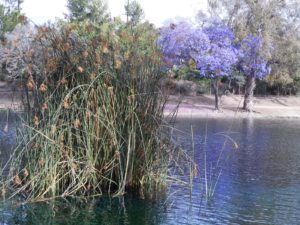
A large image from June 17 of Tule Reed (Schoenoplectus acutus). Tongva people made huts and boats out of this strong and light tubing. A purple blue Jacaranda tree beams across the lake.
4d. May 21 2019 Brea Dam Park
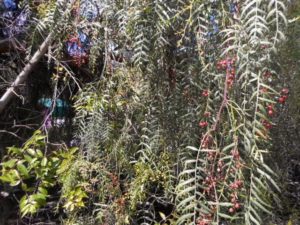
Pepper trees are the most common wild trees in the area. Peruvian Pepper (Schinus molle) and Brazilian Pepper (Schinus terebinthifolia) look the same but flower at different times. They are not true peppers (Piper nigrum), but their fruit looks and tastes similar.
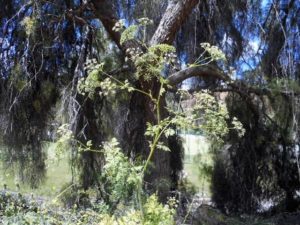
In front of a Pepper Tree is Poison Hemlock (Conium maculatum), a naturalized plant from Europe. The roots and seeds contain dangerous alkaloids. A mouthful will kill an adult person.

This is a native tree, Colorado Pinyon Pine (Pinus edulis). This 2-needle and the 1 and 4-needle Pinyon Pine varieties grow at low elevations along the desert slopes of Southern California.
4e. June 1 2019 Juanita Cooke Trail
This scenic trail through now-residential Fullerton was once the Pacific Electric railroad that carried commuters in red trolley cars between Fullerton and La Habra. Pine, eucalyptus, and other trees were planted alongside the route, that are now old giants over 50 feet tall.
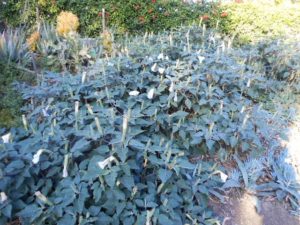
This is Sacred Datura (Datura meteloides) aka Angel’s Trumpet. The flowers are big white trumpets. This plant contains tropane alkaloids that are hallucinogenic and toxic. It has been used for centuries in religious ceremonies for the spiritual feeling it induces.
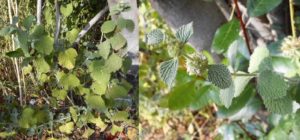
A happy Horehound (Marrubium vulgare). This plant from the mint family is used for medicinal tonic and horehound candy.
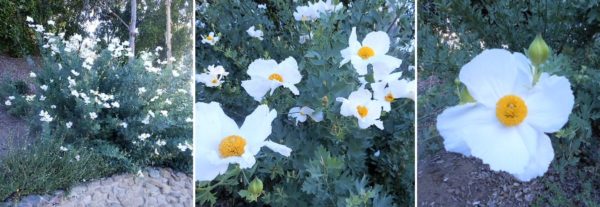
All rise for the “Queen of the California Wildflowers”, the Matilija Poppy (Romneya coulteri). The queen stands over six feet tall with huge white deliciously fragrant flowers.
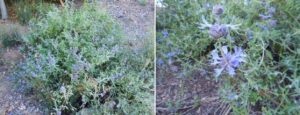
Here is a lovely Purple Sage (Salvia leucophylla). It is the most beautiful local sage. Would you agree?
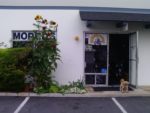 5. Urban Flatland, Fullerton CA
5. Urban Flatland, Fullerton CA
Wild plants in urban areas are usually called weeds. They grow along railroad tracks or in undeveloped places that are not cared for. The oldest railroad tracks, from the 1800’s, have strips of untouched land on either side, that are unofficial nature preserves. This land has never been plowed or disturbed, and contains seeds and plants that were original to that area.
The sides of the BNSF/Amtrak 3-track mainline next to Myrons Mopeds are that kind of nature preserve wasteland. Every May, tall sunflowers bloom, with prickly pear cactus, tree tobacco, wild watermelon and many other smaller plants, all within 500 feet of the shop. Many of the original 1890’s telegraph poles with glass insulators remained there until the 1990’s.
5a. May 6 2019 Myrons Mopeds
These plants are all within a few hundred feet of Myrons Mopeds.
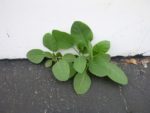
Here’s a baby Tree Tobacco (Nicotiana glauca). As you can see it grows everywhere. This plant was used for medicinal purposes and smoked by Native American groups. In addition to nicotine, it contains the toxic alkaloid anabasine, and ingestion of the leaves can be fatal.
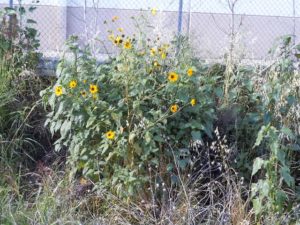
Here comes the Common Sunflower (Helianthus annuus), along the 1890’s Santa Fe tracks. Only homeless people, train crews and passengers get to see these six foot tall wonders.
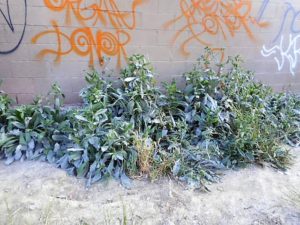
This is Stinging Nettles (Urtica holosericea). It has barbed hairs on the stems that release formic acid when they pierce the skin, like an ant bite does. On the good side, it’s young shoots can be eaten and provide health benefits.
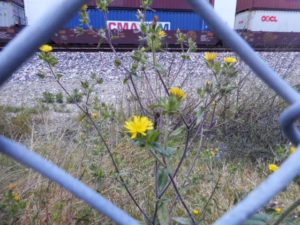
Stinging Nettles flowering, with a BNSF freight train passing by. Each train has several engines pulling over 100 containers. One passes by about every hour. That’s over 2000 shipping containers per day.
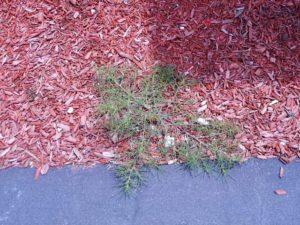
This is a baby Russian Thistle (Salsola tragas) aka Western Tumbleweed, growing through weed-stopping mulch where weed killer was recently sprayed!
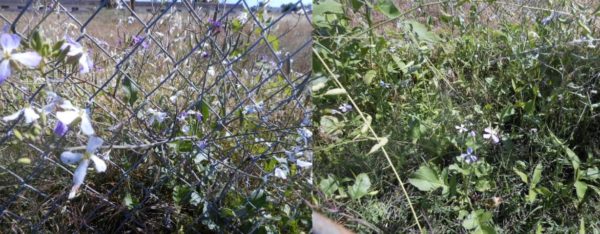
This is Wild Radish (Raphanus sativus), a common weed. The 4-petal flowers are white in the middle and purple at the tips.
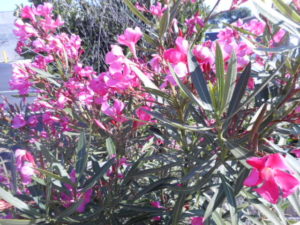
This is from June 12, a blooming Desert Willow (Chilopsis linearis). It’s not a willow, but it is both a native wild plant and a common landscape plant. It makes plenty of color for very little water.

This common plant called Cheese Weed (Malva parviflora), because the tiny fruits are shaped like rounded cheeses. It is also known as Mallow. The lavender flowers are not usually visible because they don’t last long.
5b. May 24 2019 La Mirada Union Pacific Tracks
This walk starts at the border between the city of Buena Park in Orange County, and the city of La Mirada in Los Angeles County, on Artesia Blvd and Knott Ave. There the 1800’s Union Pacific single railroad track crosses near that intersection, heading northwest toward downtown Los Angeles. Along the sides are places where wild plants thrive in dense patches, maybe 50 by 100 feet, where one kind of plant dominates. Patches of Wild Rye Grass, Common Thistle, Horseweed, Napa Thistle, Bristly Ox-tongue, Sow Thistle, Stinging Nettles, and Milk Thistle are all there.
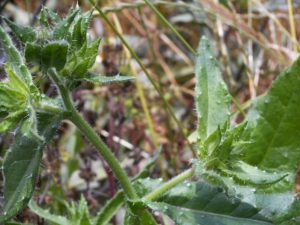
Bristly Ox-tongue (Picris echioides) grows everywhere, including lawns and gardens. The leaves have wart-like bumps, and bristles everywhere.
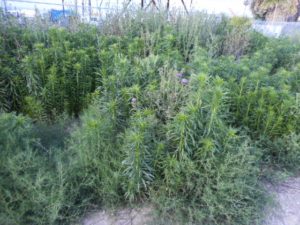
Here is a patch of Horseweed (Erigeron canadensis), surrounding a lone thistle. Horseweed has a single stalk, thin plain leaves, and when mature, a bunch of tiny white flowers on top. It’s the most abundant weed in the area.

This is a very common trail side plant called Star Thistle (Centaurea melitensis) aka Napa Thistle. The flowers have brown spines that say “do not eat” in plant talk.
6a. May 19 2018 Cal State University Long Beach
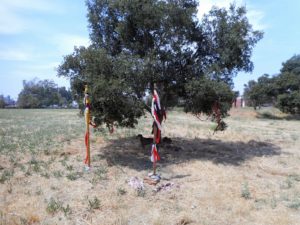
This is Puvunga, on the campus of CSULB. The tree is a Coast Live Oak (Quercus agrifolia), decorated and respected. It’s leaves are more cup-shaped than scrub oak, the holly-like leaf points are smaller, and the trunk is straighter.
From Wikipedia: Puvunga (alternate spelling: Puvungna) is an ancient village and burial site thought to have once been populated by the Tongva (Gabrieliño) people, who are the indigenous inhabitants of the region around Los Angeles, California. The site is located near the Earl Burns Miller Japanese Garden on the campus of present-day California State University, Long Beach, along the banks of a now channelized creek, about three miles (5 km) from the Pacific Ocean. Puvunga is believed to be the birthplace of Chingishnish, the major deity or culture hero in Tongva mythology, and claimed as sacred, by some Tongva tribal council representatives.
A portion of the site (which is unmarked with a sign or other informational marker) comprises a natural area located at the edge of campus, near a parking lot. At one time this site had a natural spring, and the location is sometimes referred to as Puvunga Spring. Another similar (but larger) Tongva site is Kuruvungna Springs on the grounds of University High School in Los Angeles.
This ancient village and burial site is on the US National Register of Historic Places.
6b. June 16 2019 Coyote Creek Park, Los Alamitos
A few miles after Coyote Creek flows southwest past Coyote Hills, it merges with the San Gabriel River south of Katella Ave, in northeast Long Beach. A little before that, north of Katella, is a long thin nature park along the concrete channel. It is property of So Cal Edison because it is under power lines, but is maintained by the city of Los Alamitos. The sign there says watch your pets, coyotes frequent the area. They commute in the concrete channels, avoiding the traffic and urban sprawl.
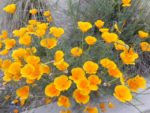
The state flower is the cheerful California Poppy (Eschscholzia californica). It was used by native people as a cosmetic.
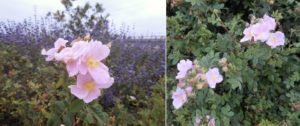
A lovely pink California Wild Rose (Rosa californica) in front of Purple Sage. It’s a summer chorus of sight and smell.
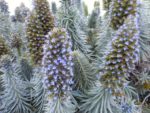
This is Pride of Madeira (Echium candicans), from Madeira Island, Portugal. It’s a popular ornamental that invades wild areas near the ocean.
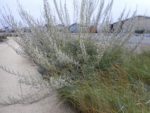
This is Black Sage (Salvia mellifera) with light lavender flowers, almost white. Native people ate the nutritious black seed nuts and used the aromatic leaves and flowers for tea and medicine.
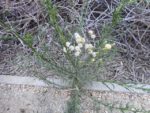
Here, there and everywhere is Flax-leaved horseweed (Erigeron bonariensis), aka Argentine fleabane. It’s a world-wide weed.
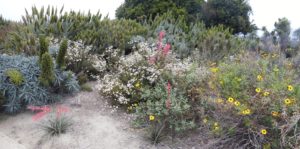
Large image of the best spot. L to R, Pride of Madeira (blue), unknown (red), Chamise (white), California Brittlebrush (yellow).
7. Sources and Discussion
1. Google
1. Images
2. Wikipedia
3. calflora.org
3. California
3. wild plants
Nature is wonderful! It has endless variety and beauty. Living things have countless strategies for survival. It’s enough just to experience nature for it’s soothing effect. It’s more satisfying to understand what everything is, how it works, and how it got there.
Walking down a (Fullerton, California) nature trail, and being able to name and explain the plants seen from the trail, was the goal of this botanical study. Knowing which plants belong there and which ones don’t is insightful. Humans have inadvertently brought plant seeds from around the world. Some of those have taken hold and taken over, pushing out the native plants. The yellow fields of wild mustard or wild cabbage in particular are some of those ruthless invaders. It is beautiful to look at that carpet of yellow, but like looking at distant lightning or a tornado, there is also unseen damage and destruction.
